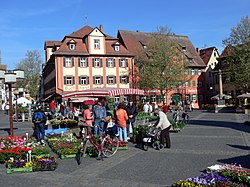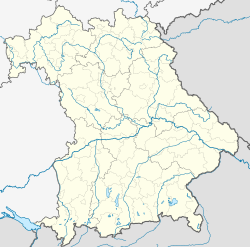Schwabach | |
|---|---|
 Market square | |
| Coordinates: 49°19′45″N 11°1′15″E / 49.32917°N 11.02083°E | |
| Country | Germany |
| State | Bavaria |
| Admin. region | Middle Franconia |
| District | Urban district |
| Government | |
| • Lord mayor (2020–26) | Peter Reiß[1] (SPD) |
| Area | |
| • Total | 40.71 km2 (15.72 sq mi) |
| Elevation | 326 m (1,070 ft) |
| Population (2022-12-31)[2] | |
| • Total | 41,227 |
| • Density | 1,000/km2 (2,600/sq mi) |
| Time zone | UTC+01:00 (CET) |
| • Summer (DST) | UTC+02:00 (CEST) |
| Postal codes | 91101–91126 |
| Dialling codes | 09122, 0911 |
| Vehicle registration | SC |
| Website | www.schwabach.de |
Schwabach (German pronunciation: [ˈʃvaːbax] ⓘ) is a German city of about 40,000 inhabitants near Nuremberg in the centre of the region of Franconia in the north of Bavaria. The city is an autonomous administrative district (kreisfreie Stadt). Schwabach is also the name of the river which runs through the city prior to joining the Rednitz.
Schwabach is famous for its crafts made of gold, particularly gold foil. In 2004, Schwabach celebrated this tradition with an anniversary festival, marking "500 years gold foil in Schwabach".
Around 1500, a local typesetter developed the "Schwabacher" font. This font was used for printing the first Bible in German, which had been worked out by Martin Luther.





